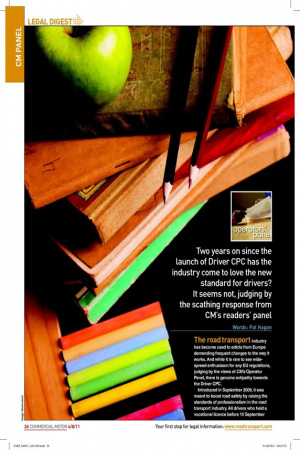So far – not so good
Page 23

Page 22

If you've noticed an error in this article please click here to report it so we can fix it.
Two years on since the launch of Driver CPC has the industry come to love the new standard for drivers? It seems not, judging by the scathing response from CM’s readers’ panel
Words: Pat Hagan The road transport industry has become used to edicts from Europe demanding frequent changes to the way it works. And while it is rare to see widespread enthusiasm for any EU regulations, judging by the views of CM’s Operator Panel, there is genuine antipathy towards the Driver CPC.
Introduced in September 2009, it was meant to boost road safety by raising the standards of professionalism in the road transport industry. All drivers who held a vocational licence before 10 September 2009 have until 2014 to complete 35 hours of training, made up of blocks of at least seven hours. New drivers need to obtain an Initial Qualification, as well as their HGV licence, to drive professionally.
VOSA and the Driving Standards Agency must be notified how much periodic training each driver has done and, from 2014, any driver without a CPC, or who fails to carry their CPC qualification card while driving, faces a £1,000 fine.
All training, which costs drivers at least £400, must be provided by bodies accredited by the Joint Approvals Unit for Periodic Training (JAUPT). Some larger firms are carrying out their own training, while others have been shopping around among the array of training firms that have sprung up in recent months.
It is still early days and most firms are in the initial stages of training, or have not even started. But while nobody appears to contest the aims of the Driver CPC, there are deep-rooted concerns that the standard of training is poor, that older drivers will leave the industry rather than pay hundreds of pounds to learn what they have been doing for years and that, in the final analysis, there will be little or no measurable improvement in industry standards. ■















































